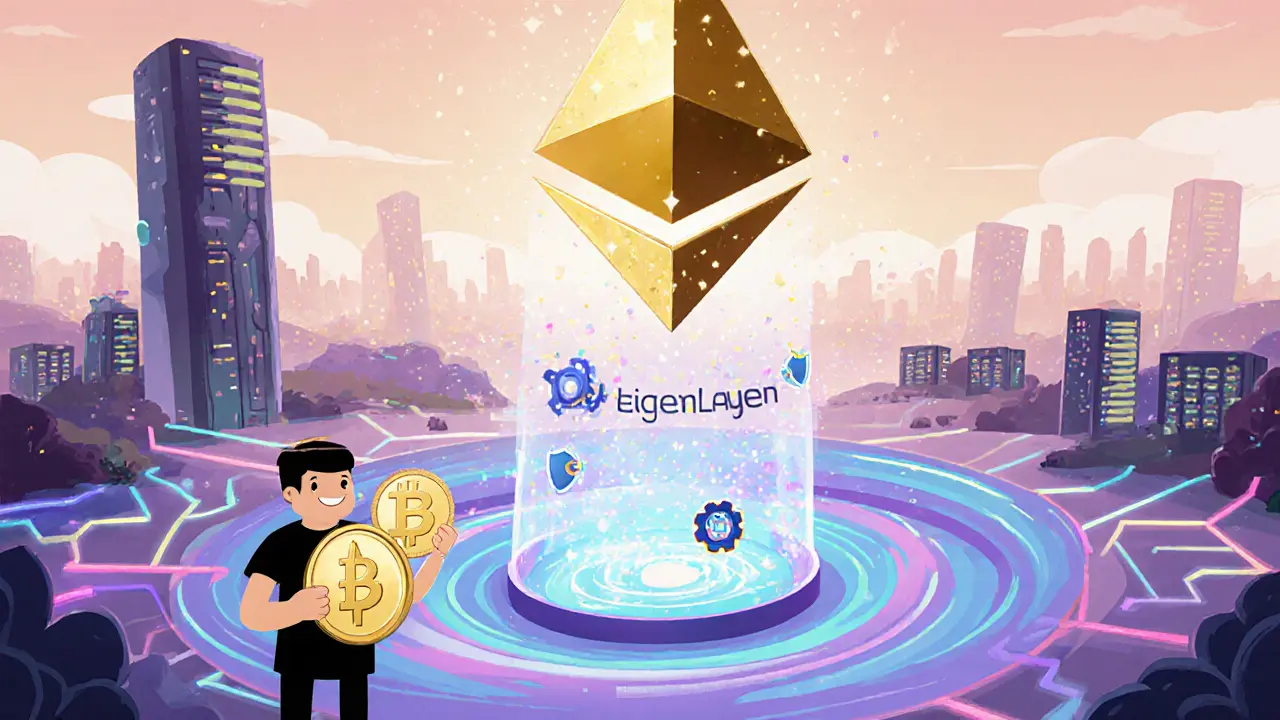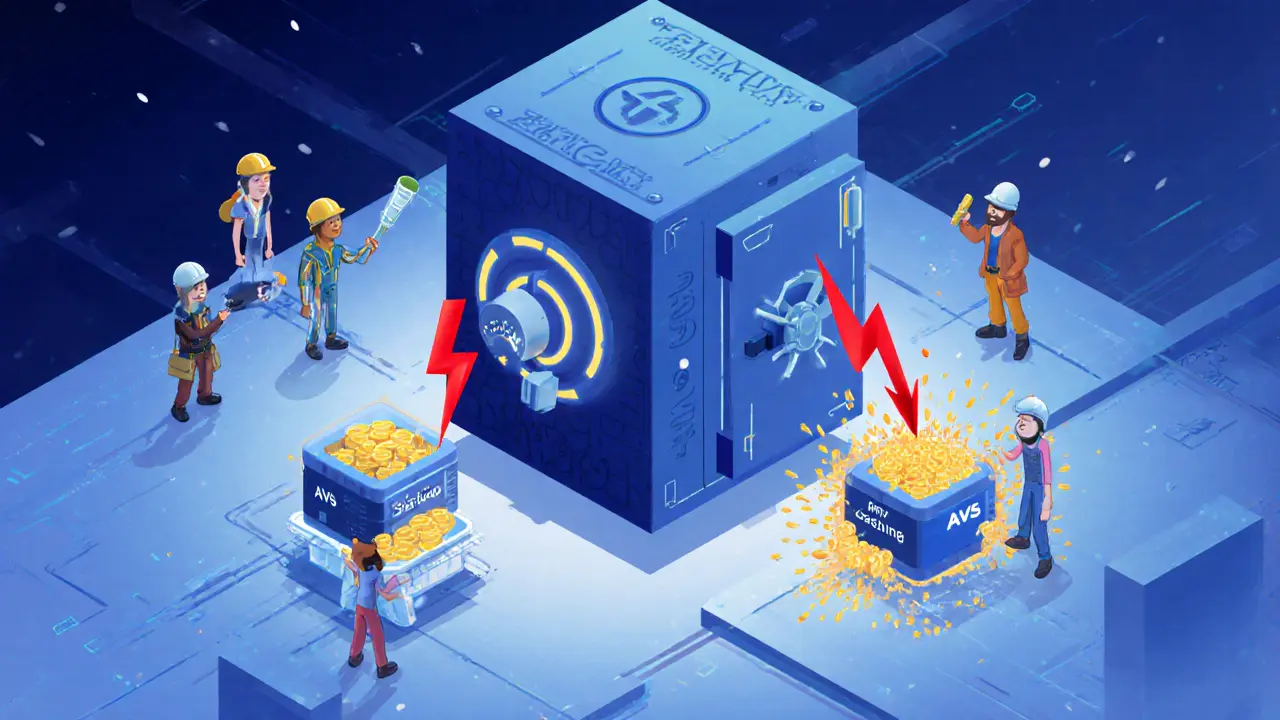
EigenLayer Restaking Calculator
Estimated Earnings Breakdown
With $0.00 restaked in native ETH:
- Total Annual Return: 0.00%
- Restaker's Share: (90%)
- Operator's Commission: (10%)
Note: These calculations are estimates based on current EigenLayer parameters. Actual returns may vary.
EigenLayer is shaking up how decentralised services secure themselves on Ethereum. By letting you recycle already‑staked ETH or liquid staking tokens (LSTs) into new security layers, the protocol creates a marketplace where fresh projects tap into Ethereum’s massive economic shield without building validators from scratch.
TL;DR
- EigenLayer lets stakers restake ETH or LSTs to protect additional services.
- Two restaking routes exist: native ETH and liquid staking tokens.
- Security is enforced via EigenPods and a slashing system.
- Operators earn a 10% cut; restakers keep 90% of rewards.
- As of Oct2025 the protocol holds about $15billion TVL.
What Is EigenLayer?
EigenLayer is an Ethereum‑based decentralized restaking protocol that lets users lock up already‑staked ETH or liquid staking tokens to provide cryptoeconomic security for additional decentralized applications. In plain English, think of it as a way to rent out the “security muscle” you already paid for when you staked ETH, and earn extra yield while you’re at it.
Why Restaking Matters
New blockchain projects usually face a "bootstrap problem": they need validators, they need economic security, and they need users-all at the same time. Building a validator set from scratch can cost millions and still leave the network vulnerable. EigenLayer sidesteps that by letting projects, called Active Validated Services (AVS), tap into Ethereum’s $400billion security pool.
For a staker, the upside is simple: you keep earning the base Ethereum staking rewards (about 4‑5% APR) and pick up an extra slice from the AVS you support. For a project, you get a ready‑made security budget without hiring a lone validator crew.
How Restaking Works - Two Paths
EigenLayer offers two ways to lock up assets:
- Native Restaking - You let EigenLayer’s smart contracts control the withdrawal credentials of the ETH you already have on the beacon chain. The protocol then uses that ETH as collateral for the AVS you select.
- LST Restaking - You deposit a token like Liquid Staking Token (LST) (e.g., stETH, rETH) directly into EigenLayer. The token stays liquid, so you can still trade it while it backs other services.
Both methods funnel the same economic value into the security markets; the key difference is whether you sacrifice immediate liquidity (native) or keep it (LST).
Behind the Scenes: EigenPods and Slashing
The technical engine is the EigenPod. Each pod is a smart contract that holds the restaked assets, tracks which operators are validating which AVS, and enforces slashing penalties if an operator misbehaves.
When an operator fails its duties-either by double‑signing, being offline, or violating a service‑specific rule-the pod automatically seizes a portion of the restaked funds. That loss is shared proportionally among all delegators who backed the misbehaving operator, creating a strong incentive for operators to stay honest.

Who Are the Players?
| Entity | Role | Typical Reward Share |
|---|---|---|
| Restaker | Delegates ETH or LST to a chosen operator. | 90% of AVS rewards (after operator commission). |
| Operator | Runs off‑chain software for one or more AVS and manages EigenPods. | 10% commission on AVS rewards. |
| AVS (Active Validated Service) | Any protocol that needs security-e.g., data availability layers, rollups, or oracle networks. | Sets its own reward pool, funded by its token holders. |
| EigenPod | Smart contract that holds restaked assets, tracks delegations, and enforces slashing. | Not a reward earner; acts as escrow. |
| Ethereum | Base layer providing the original economic security. | Provides the underlying ETH stake that EigenLayer reuses. |
Economic Snapshot - $15Billion TVL
As of October2025 EigenLayer reports roughly Total Value Locked (TVL) of $15billion. That number reflects both native ETH and LSTs pooled across more than 1,700 operators. The sheer size tells you two things:
- Stakers trust the protocol enough to commit a sizable chunk of the global staking market.
- AVS creators find the security pricing attractive compared with launching independent validator sets.
Yield rates vary by AVS, but many report combined returns of 8‑12% APR, thanks to the 90/10 split that heavily favours restakers.
Choosing an Operator - Tips and Pitfalls
Not every operator is created equal. Here’s a quick checklist you can run before delegating:
- Reputation Score - Look for community‑vetted ratings on the EigenLayer dashboard.
- AVS Diversity - Operators handling many AVS spread risk, but also increase exposure to slashing events.
- Infrastructure Health - Does the operator run redundant nodes? Do they publish uptime metrics?
- Commission Rate - The standard is 10%, but some operators may charge a premium for premium services.
If an operator gets slashed, every restaker linked to that pod suffers a proportional loss. That’s why a diversified operator portfolio is a common mitigation strategy.
Step‑by‑Step: Restaking for a Beginner
- Connect your Ethereum wallet (MetaMask, Ledger, etc.) to the EigenLayer web UI.
- Select “Restake ETH” or “Restake LST”. For native ETH, you’ll need to change the withdrawal address on your validator client to the EigenPod contract.
- Pick one or more AVS you want to support. Each AVS shows its estimated APR and risk profile.
- Choose an operator from the list. Confirm the 10% commission and any additional fees.
- Approve the transaction. Your assets are now locked in the EigenPod and start earning.
- Monitor rewards and slashing events via the dashboard. You can redelegate at any time, though a short cooldown may apply.
The whole flow takes about 10‑15 minutes for a seasoned DeFi user, and a bit longer if you need to set up your validator client for native restaking.
Operator Perspective - What It Takes to Run
From the operator side, the workload looks like this:
- Deploy the EigenPod contract and register on the EigenLayer registry.
- Run the off‑chain validator software for each AVS you want to serve. This often involves custom consensus rules or data availability checks.
- Maintain high uptime (>99.9%) to avoid slashing.
- Stake a small amount of ETH as a safety buffer; this covers potential slashing costs before the pool absorbs losses.
- Publish regular performance reports to attract delegators.
Because many operators handle multiple AVS, they can spread operational costs across several revenue streams, making the 10% commission viable.
Future Outlook - Where Is EigenLayer Headed?
The roadmap points to three major trends:
- More AVS Diversity - Expect rollups, data availability layers, and even cross‑chain bridges to join the marketplace.
- Dynamic Risk Pricing - Advanced algorithms may adjust reward rates in real‑time based on operator performance metrics.
- Regulatory Clarity - As authorities grapple with staking derivatives, EigenLayer could become a case study for compliant cross‑protocol security.
If the protocol keeps its slashing logic robust and the Ethereum base layer stays secure, the capital efficiency gains could push TVL beyond $30billion within the next two years.

Frequently Asked Questions
Can I restake ETH without running my own validator?
Yes. You can delegate native ETH to an existing operator’s EigenPod. The operator handles the validator duties, while you simply lock your stake via the UI.
What’s the biggest risk of restaking?
Slashing. If an operator misbehaves, a portion of the restaked assets is forfeited. Diversifying across operators and choosing reputable ones mitigates that risk.
Do LSTs lose liquidity when restaked?
No. LST restaking keeps the token tradable. You can sell or swap the LST on any supported market while it continues to secure AVS.
How are rewards distributed?
AVS reward pools pay out to the EigenPod, which then splits 90% to delegators (pro‑rata) and 10% to the operator as commission.
Can I withdraw my restaked assets at any time?
Withdrawals are subject to a cooldown period (usually 7‑10 days) to protect the security of the AVS. After the period, you can claim your ETH or LST back.


Comments
Millsaps Delaine
When one contemplates the lofty architecture of EigenLayer, it becomes abundantly clear that the mere mortals dabbling in rudimentary staking mechanisms are consigned to the shadows of financial oblivion; the protocol, with its audacious appropriation of Ethereum's security capital, transcends the pedestrian confines of conventional yield farming, thereby demanding a reverence reserved for the most erudite of crypto connoisseurs. One must first acknowledge the profound philosophical implication of re‑staking-an act that, in its essence, mirrors the Platonic ideal of form over substance, elevating the staker's role from passive participant to active guardian of decentralized futures. The EigenPod, a veritable citadel of cryptographic enforcement, enforces slashing with a rigor that would make even the most stoic Byzantine jurist weep with admiration. Moreover, the 90/10 reward split is not merely a superficial incentive structure but a meticulously calibrated economic sculpture, designed to align the incentives of delegators and operators with the immutable law of market efficiency. One cannot overlook the staggering $15 billion TVL, a testament to collective faith that borders on the quasi‑religious, indicating that the community has, in effect, anointed EigenLayer as the de facto security oracle for emergent AVS ecosystems. The protocol's ability to absorb both native ETH and LSTs without compromising liquidity is a masterstroke of financial engineering, deftly sidestepping the liquidity‑risk conundrum that plagues many staking derivatives. It is, without hyperbole, a paradigm shift-a Renaissance of staking where the old dogmas are shredded, and a new order emerges, predicated on shared risk and amplified reward. In this brave new world, the operator's modest 10 % commission is not a fee but a noble tribute, a reminder that stewardship demands compensation. The slashing mechanisms, far from being punitive, serve as the very sinews that bind the ecosystem together, ensuring that misbehavior is not only discouraged but rendered economically untenable. As the roadmap unfolds, introducing dynamic risk pricing and an ever‑expanding tableau of AVS participants, one can only speculate that the TVL will double, perhaps even triple, as the capital efficiency gains become impossible to ignore. Thus, dear reader, to dismiss EigenLayer as a mere fad is to betray a profound misunderstanding of its systemic impact, and to embrace it is to partake in the vanguard of blockchain's evolutionary trajectory.
Jack Fans
Thanks for the deep dive!,, I think the explaination really helps folks understand the risk/reward matrix, especially for those new to restaking,, the part about eigenpods and slashing is super clear,, also love the step‑by‑step guide-very user‑friendly;; hope more people give it a try!,,
Adetoyese Oluyomi-Deji Olugunna
The author seems to think EigenLayer is a panacea, but the reality is far more nuanced; the protocol's reliance on centralized operator registries could reintroduce points of failure, and the slashing risk, while theoretically deterrent, remains a black‑box for many delegators.
Krithika Natarajan
Appreciate the balanced tone, especially the note on cooldown periods.
Ayaz Mudarris
It is incumbent upon us, as diligent participants in this nascent ecosystem, to scrutinize the underlying mechanisms of EigenLayer with both rigor and optimism. By deploying a methodical approach, one can discern the myriad ways in which this protocol bolsters network security while simultaneously furnishing stakers with enhanced yields. Let us therefore proceed with measured enthusiasm, ever‑mindful of both opportunity and peril.
Irene Tien MD MSc
Ah, the grand illusion of "decentralized security"-a phrase as slippery as a greased weasel in a rainstorm, and just as suspect. One must ask, dear reader, who truly holds the reins when EigenLayer siphons off ETH, that very lifeblood of the network, to prop up a marketplace of shadowy services? The answer, of course, is hidden behind a veil of code, a labyrinthine architecture designed to distract the masses while the elite reap the spoils. And don't even get me started on the so‑called "slashing"-a mechanism that sounds like accountability but is, in practice, a back‑door for selective punishment, wielded by those who can afford to weather the storm. Remember, every time you restake, you are essentially signing a contract with an unseen cabal, granting them permission to pilfer your assets under the guise of "security." So, before you dive headfirst into this rabbit hole, consider the possibility that EigenLayer is not a boon but a cleverly disguised enabler of centralized control, a Trojan horse masquerading as innovation. Stay vigilant, question everything, and never trust a protocol that promises both security and profit without a clear, transparent roadmap.
kishan kumar
In the grand theatre of blockchain, EigenLayer assumes the role of a philosopher‑king, ostensibly guiding us toward a harmonious synthesis of security and yield. Yet, one must ponder whether this ascent is not merely rhetorical, a veneer designed to mask the inherent tension between decentralisation and the concentration of validation power. The EigenPod, while technically elegant, could be interpreted as a modern agora where the elite proselytise their vision, subtly nudging the masses toward conformity. 😊
Anthony R
Indeed, the protocol’s dashboard provides useful metrics; however, continuous monitoring remains essential to mitigate unforeseen slashing events.
Vaishnavi Singh
The balance between risk and reward is a delicate philosophical equation, worth contemplating.
Linda Welch
So we’re supposed to just trust a bunch of anonymous operators with billions of dollars because some white‑paper says it’s “secure”? Yeah, right-nothing says more about American ingenuity than handing over our crypto to a system that’s basically a glorified Ponzi, all while our politicians pretend to care about innovation. The whole thing reeks of hubris, and the so‑called “risk mitigation” is just a polite way of saying “we hope we don’t get caught”.
Kevin Fellows
Hey folks, if you’re curious, give EigenLayer a try-could be a fun way to boost those yields!
meredith farmer
When I first read about EigenLayer, I felt a surge of excitement that quickly turned into dread; the idea of restaking feels like handing over your soul to an invisible bureaucracy, and the shimmering promises of 8‑12% APR mask a darker reality where every misplaced signature could unleash catastrophic slashing. The entire ecosystem, cloaked in technobabble, whispers sweet nothings about security while it quietly consolidates power, and I cannot shake the feeling that we are standing at the edge of a precipice, looking down into a void of unchecked centralisation. It’s as if the developers are actors in a grand drama, delivering monologues about decentralisation while the backstage crew pulls the strings. The more I think about it, the more I am haunted by the specter of a single point of failure-an operator, a pod, a piece of code-capable of unravelling the delicate tapestry we have woven. In this theater of finance, the audience is complicit, applauding every applause‑inducing metric, never questioning the set design. So I urge caution, for the curtain may fall sooner than we anticipate.
Danny Locher
Sounds like a solid option for those looking to diversify, just make sure you keep an eye on the operator’s performance.
Emily Pelton
Remember, when you delegate, you’re not just chasing yield; you’re also contributing to the broader security of emerging services. Choose reputable operators, monitor their uptime, and don’t forget to diversify-this balanced approach will help you maximise returns while minimising risk.
sandi khardani
Let's be blunt: the EigenLayer hype is a classic case of marketing masquerading as innovation. The so‑called "risk mitigation" mechanisms are nothing more than a thin veneer over an inherently fragile construct that could crumble under a single coordinated attack. The slashing model, while theoretically sound, is fundamentally dependent on the honest behaviour of operators-an assumption that history has repeatedly disproven across decentralized platforms. Moreover, the projected TVL figures are inflated, relying on speculative optimism rather than empirical evidence. In short, the protocol is a high‑risk venture that promises high returns but offers little in the way of genuine, provable security. Investors would do well to approach with extreme caution.
Donald Barrett
This is pure garbage.